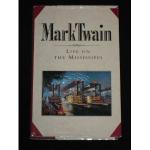Six miles below town a fat and battered brick chimney, sticking above the magnolias and live-oaks, was pointed out as the monument erected by an appreciative nation to celebrate the battle of New Orleans—Jackson’s victory over the British, January 8, 1815. The war had ended, the two nations were at peace, but the news had not yet reached New Orleans. If we had had the cable telegraph in those days, this blood would not have been spilt, those lives would not have been wasted; and better still, Jackson would probably never have been president. We have gotten over the harms done us by the war of 1812, but not over some of those done us by Jackson’s presidency.
The Warmouth plantation covers a vast deal of ground, and the hospitality of the Warmouth mansion is graduated to the same large scale. We saw steam-plows at work, here, for the first time. The traction engine travels about on its own wheels, till it reaches the required spot; then it stands still and by means of a wire rope pulls the huge plow toward itself two or three hundred yards across the field, between the rows of cane. The thing cuts down into the black mold a foot and a half deep. The plow looks like a fore-and-aft brace of a Hudson river steamer, inverted. When the negro steersman sits on one end of it, that end tilts down near the ground, while the other sticks up high in air. This great see-saw goes rolling and pitching like a ship at sea, and it is not every circus rider that could stay on it.
The plantation contains two thousand six hundred acres; six hundred and fifty are in cane; and there is a fruitful orange grove of five thousand trees. The cane is cultivated after a modern and intricate scientific fashion, too elaborate and complex for me to attempt to describe; but it lost $40,000 last year. I forget the other details. However, this year’s crop will reach ten or twelve hundred tons of sugar, consequently last year’s loss will not matter. These troublesome and expensive scientific methods achieve a yield of a ton and a half and from that to two tons, to the acre; which is three or four times what the yield of an acre was in my time.
The drainage-ditches were everywhere alive with little crabs— ‘fiddlers.’ One saw them scampering sidewise in every direction whenever they heard a disturbing noise. Expensive pests, these crabs; for they bore into the levees, and ruin them.
The great sugar-house was a wilderness of tubs and tanks and vats and filters, pumps, pipes, and machinery. The process of making sugar is exceedingly interesting. First, you heave your cane into the centrifugals and grind out the juice; then run it through the evaporating pan to extract the fiber; then through the bone-filter to remove the alcohol; then through the clarifying tanks to discharge the molasses; then through the granulating pipe to condense it; then through the vacuum pan to extract the vacuum. It is now ready for market. I have jotted these particulars down from memory. The thing looks simple and easy. Do not deceive yourself. To make sugar is really one of the most difficult things in the world. And to make it right, is next to impossible. If you will examine your own supply every now and then for a term of years, and tabulate the result, you will find that not two men in twenty can make sugar without getting sand into it.




